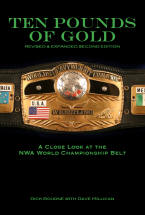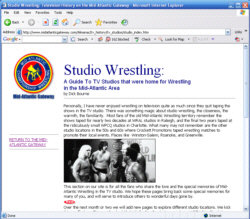|
|
|||
|
MID-ATLANTIC GATEWAY ALMANAC The Birth of Televised Wrestling in Charlotte AND A BRIEF HISTORY OF MID-ATLANTIC WRESTLING ON TELEVISION By Dick Bourne |
|||
|
A Guide to the TV Studios where wrestling was taped for Jim Crockett Promotions WBTV • WFBC • WRAL WDBJ • WGHP • WCCB WPCQ • WTBS NEWSPAPER ARTICLES ON TV WRESTLING
By Mark Wolf - The Charlotte Observer, March 25, 1978 WRESTLING AUDIENCE GREATLY EXPANDED ON TV By Mark Gillespie, Charleston Post & Courier, Sept. 23, 1978 A Close Look at the NWA World Championship Belt by Dick Bourne and Dave Millican Only $12.95
|
With the advent of television in the 1940s, the national TV networks were desperate for inexpensive programming to fill their broadcast schedule. One of the most successful early forms of programming was professional wrestling, which typically originated from one of the major broadcast centers like New York or Chicago.
Local broadcasting was quickly evolving in the la In 1958, Charlotte, NC television station WBTV partnered with local wrestling promoter Jim Crockett to produce live televised wrestling bouts in Charlotte. The arrangement was advantageous for both parties. WBTV needed programming, and Jim Crockett benefited from an effective and far reaching way to promote his weekly wrestling cards at the Charlotte Park Center.
On Saturday, January 11, 1958, WBTV aired its first live broadcast of professional wrestling. Local newspapers in communities around Charlotte began to spread the word about the new program called "Live Championship Wrestling." (An article from the Gastonia (NC) Gazette is included here, at right.) Both parties used this new arrangement to build loyal audiences that lasted for decades afterwards.
FURTHER TV HISTORY In the 1960s, Jim Crockett developed similar arrangements with local television stations in other cities like High Point and Raleigh NC, Greenville SC, and Roanoke VA. Each show helped promote local Crockett cards and provided highly-rated programming for the local station. Some of these stations taped the wrestling bouts while others continued to broadcast live matches. WBTV began live, and then began taping the live matches on Wednesday evenings at their studio to be aired on the following weekend. In the early 1970s, Jim Crockett Jr., now running the family business with his brothers and sister after the death of their father, began to consolidate television tapings. WRAL in Raleigh was chosen to be the central taping location, with tapes of the shows being distributed to other affiliate stations in the Crockett network across The Carolinas and Virginia. (See this sample affiliate listing from 1977.) In the 1980s, tapings moved back to Charlotte to the studios of WPCQ television, and then soon after out into small arenas. Jim Crockett Promotion's TV network had grown to include parts of West Virginia, Georgia, and Florida, as well as expansion to selected markets in the northeast like Baltimore and Philadelphia. With the purchase of national TV time on cable superstation WTBS out of Atlanta, Crockett began to also expand the syndicated network nationally. This expansion, and the costs associated with it, were one of the factors that led to the sale of the company by the Crockett family to Turner Broadcasting in late 1988. A Guide To TV Studios that were home for Wrestling in the Mid-Atlantic Area
|
Live Wrestling is slated on WBTV Saturday Gastonia Gazette, January 7, 1958 (ACTUAL CLIPPING SEEN BELOW)
WBTV will kickoff a schedule of “Live Championship Wrestling” Saturday, Jan. 11 at 3:45 PM according to an announcement by WBTV Production Manager Rob Rierson.
The weekly Saturday afternoon matches will originate from the studios of WBTV and are being televised in cooperation with Jim Crockett Promotions.
“Telecasts of live bouts have been a big hit in other sections of the country,” Rierson said, and we feel that they will be just as popular in the sports minded area we serve. The tremendous success of Jim Crockett’s Monday night cards at the Park Center gives an indication of the popularity of the sport.”
Most of the top names of the wrestling trade will be featured on the telecasts. Included in the group are Mike Clancy, junior heavyweight champion, George Becker and Dick Steinborn, Southern tag team holders, Doc Gallagher, Kurt Von Hess, Luigi Macera, Jim Austeri, Tom Bradley, Johnny Heidman, Gypsy Joe, and the Elephant Boy.
Saturday’s opening card will pit Irish Mike Clancy against Jim Austeri in the feature bout with Luigi Macara taking on Gypsy Joe in the windup. Both of the matches will be the two out of three falls variety with a 30-minute limit on each fall.
The format will be the same every Saturday, two matches with the two out of three falls, 30-minutes time limit rule in effect.
George Becker and Dick Steinborn will meet Tom Bradley and Johnny Heidman in a tag team match in the feature bout Saturday, Jan. 18.
Big Bill Ward, host of "Live Championship Wrestling" on WBTV
“Big Bill” Ward, WBTV’s sports director, and Leo Voss will handle the announcing and color commentary.
Wrestling fans who wish to attend the matches in person can obtain tickets for the television cards by writing to Jim Crockett Promotions in Charlotte or in care of WBTV.
___________
(Gastonia Newspaper Research by Barry Caldwell. Thanks to Barry for sending this clipping and helping us pinpoint this historic day in Mid-Atlantic Wrestling history.)
|
|
|
The First Televised Matches for Crockett Promotions (January 7, 1958) Mike Clancy vs. Jim Austeri Luigi Macera vs. Gypsy Joe Commentators: Big Bill Ward and Leo Voss RETURN TO THE MID-ATLANTIC GATEWAY ARCHIVES
|
|||







